
Compartment 2 covers an area of the common between the cruise missile bunker area (GAMA site, not part of the common) to the north, the A339 Basingstoke road to the south and Brackenhurst Lane to the east. Land to the west is not part of the common, except for a narrow strip adjacent to the southwest corner of the GAMA site, which connects with Compartment 1. Compartment 3 lies to the east, beyond Brackenhurst Lane.
There are two distinct subcompartments with a total area of 17.9 ha, the first known locally as Brackenhurst Heath, and the second as Peckmoor Copse. Brackenhurst Heath was the site of one of the peace camps, and some artwork and earthworks are still visible. Peckmoor Copse is a fragment of a larger wood that was once managed for oak and hazel coppice. The whole compartment is available for grazing by cattle and Exmoor ponies.

General description and evaluation of ecology
Brackenhurst Heath contains diverse heathland communities, ranging from pioneer to mature heath, together with scattered scrub, brambles, bracken and patches of acid grassland. There is also a spring head with associated damp heath and mire vegetation. Species known to use the heath include woodlark, nightjar and a range of reptiles. There is also potential for heathland restoration at the expense of birch scrub, where relic heath communities exist.
Peckmoor Copse contains remnants of ancient woodland, with a rich ground flora including bluebells and wood sorrel. The woodland is also important for butterflies, fungi, bats, and dormouse, and has nest boxes that form part of the formal monitoring. The woodland is bounded by an old wood-bank, which has many large old trees and stumps.
BAP habitats
- Lowland heathland (2A)
- Lowland mixed deciduous woodland (2B)
Higher Level Stewardship
Options exist for subcompartment 2A.
Overall management objectives
The heathland will have a diverse structure with areas of mature and young heather, bare ground, patches of gorse, scattered birch scrub, scattered tall pines (including some standing dead pines to provide song trees, invertebrate habitat and to host fungi) and a narrow strip of pine and birch screening the GAMA site. The edges of the heath will be maintained as woodland edge habitat with a diverse structured scrub and elements of early successional stages vegetation. Peckmoor copse will remain as a woodland. There will be a reduction in the overall number of canopy trees (especially sycamore) to promote the growth of hazel and woodland flowers. This will be achieved by opening up small glades. Peckmoor Copse has a 'natural', wild feel that should be maintained.
Subcompartment 2A (11.1 ha) Brackenhurst Heath
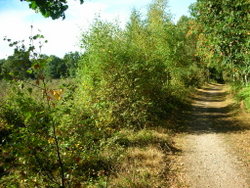
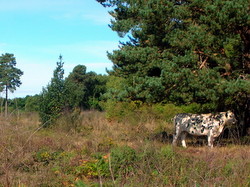

The open area known as Brackenhurst Heath is situated on a gentle south-facing slope, and consists of mature dry heath with patches of bracken, dwarf gorse, bramble and mixed age birch scrub. The heathland structure varies as some areas have been burnt (accidentally) and some cut to provide seed for heath restoration elsewhere on the common. A recently burned area in the east of the subcompartment has Cladonia lichens and some small bare patches. There are some mature individual Scots pines within the heath. The heath is surrounded by strips of mature pine and birch woodland which are, in places, spreading out into the heath. There is also a patch of humid/wet heathland with cross-leaved heath and purple moor grass, and willow scrub around a spring on the southern edge of the compartment. Nightjars nest on the heath in summer.
| Objective | Area | Method | Comment |
|---|---|---|---|
2A.1) Maintain existing area of open heath and acid grassland mosaic and continue diversifying structure.
HLS Objectives |
Open heath forming majority of subcompartment 2A. | Mow heather in strips over a 20 - 25 year rotation. (Up to 1/25 of heath area each year, preferably in 3 or more separate blocks or sinuous cuts.) Collect and remove cuttings. Create small scrapes for 1% bare ground and pioneer heather regeneration (look at creating scrapes within heather, scrub or bracken). Bank soil on northern sides to create south facing slopes for invertebrates and reptiles where appropriate. Leave small areas to develop into degenerate heather (will still need control of non-ericaceous scrub). Control birch, gorse scrub and brambles using chemicals if required. Permit patches of dense birch scrub and brambles within the heathland to develop to provide cover and song perches for birds. |
See Appendix 7 Heathland management. Potential area for reintroduction of silver-studded blue butterfly (See Appendix 5 Surveys & monitoring). Weed-wiping has been trialled here during 2012. |
| 2A.2) Increase areas of heathland and acid grassland communities where a relic flora remains under recent birch woodland. | Within and next to woodland edges around open heathland. | Cut dominant birch scrub areas. Treat birch stumps to prevent re-growth or scrape in areas where the birch is particularly dense to create new areas of pioneer heather. Scallop into woodland edge were relic heath is present. Treat stumps. | Only very small areas are likely to be restored. |
| 2A.3) Maintain woodland screen to GAMA site and Brackenhurst Lane. | Northern and eastern edges of subcompartment. | Non intervention. | |
| 2A.4) Explore the possibility of connecting heathlands. | Connect 2A with Sandleford heath (1C). | Clearance of intervening woodland. | Liaise with GAMA site owners and Natural England. A potential ‘Living Landscape’ option. |
| 2A.5) Plan for succession of trees in the open areas. | Throughout 2A | Identify and protect a small number of pine and other saplings. | To maintain a scattering of maturing trees for song perches etc. as existing trees die. |
Subcompartment 2B (6.8 ha) Peckmoor Copse
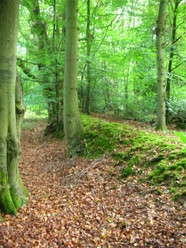
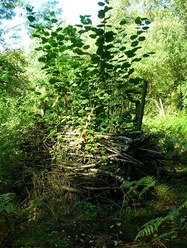
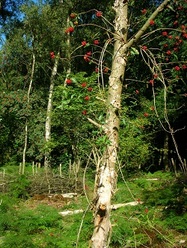
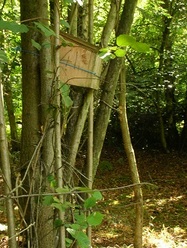
Peckmoor Copse is a fragment of ancient woodland formerly managed for oak and hazel coppice products. It is likely that the wood has been cleared and partially re-planted at some point, as there are scattered large Douglas fir, European larch, sweet chestnut and sycamore, as well as oak and birch. There is extensive young sycamore in the south-east corner and along the boundary with the A339. In places a rich ground flora of ancient woodland indicator species exists with bluebell, wood sorrel, wood anemone, yellow archangel and lily-of-the-valley being well represented. Dormouse have been found in this woodland. The wood bank bordering the northern and eastern edges of the compartment is well preserved, with some large trees.
| Objective | Area | Method | Comment |
|---|---|---|---|
| 2B.1) Continue diversifying woodland structure. | All of 2B (with exception of small areas of old hazel coppice). | Create conditions of 'natural' woodland system by cutting small glades each year by opening up the canopy, predominantly at the expense of sycamore and birch, allowing more light to reach the woodland floor to benefit hazel, ground flora and woodland invertebrates (including silver-washed fritillary and white admiral). Encourage (by selective ring-barking) standing and fallen deadwood where appropriate, and retain root plates where natural tree fall occurs. |
|
| 2B.2) Explore the feasibility of restoring a hazel coppice cycle. | Hazel dominated stands within woodland. | Seek advice from (e.g.) Berks Mammal Group, BBOWT. Coppice stools will require protection. |
Dormouse last recorded here in 2012. |
| 2B.3) Protect and manage old bank and ditch. | Bank running along north and east sides of woodland. |